No edit summary |
No edit summary |
||
| Line 142: | Line 142: | ||
[[File:Groupatmathfair.jpg|frame|right|4000x350px|Resonauts group picture at Math Fair]] | [[File:Groupatmathfair.jpg|frame|right|4000x350px|Resonauts group picture at Math Fair]] | ||
[[File:Tommathfair.jpg|frame|center|400x350px|Tom showing off the demonstration]] | [[File:Tommathfair.jpg|frame|center|400x350px|Tom showing off the demonstration]] | ||
Revision as of 03:03, 4 May 2015
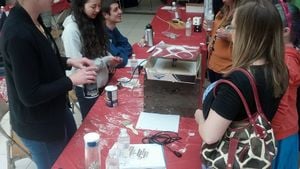
Objective
The objective of this project is to design a resonance demonstration unit for the students at Zane Middle School. The design must be portable, aesthetically appealing, and informative. The goal of the design is to provide a visual aid for the students to learn about the principles of resonance. The design should function as a safe and useful teaching tool.
What is a Chladni plate?
The Chladni Demonstration unit is based on the ideas of German Physicist Ernst Chladni, who developed the Chladni plate as a way to research sound and acoustics. He caused his plates to vibrate by bowing on them with a bow from a stringed instrument. A Chladni plate visually shows the nodes, or points of no displacement, of sound. Materials such as ceramic, glass, wood and a wide range of metals can be used for a Chladni plate. The Chladni plate can come in many shapes, although it is most commonly built as a square. The location of the nodes depends on the natural frequencies of the plate which depends on the shape, density and material used. Sand or other fine particles are placed on the top of the plate and when certain vibrations are induced on the plate, a standing wave pattern forms with the particles settling in the location of the nodes. A standing wave pattern is the pattern of the location of the nodes and anti-nodes.
Criteria
The individual criterion for the demonstration unit are defined as:
- Safety
- The ability to prevent injury of any kind to anyone using the demonstration unit.
- Educational Value
- The ability of the demonstration to visually demonstrate resonance to observers and educators in teaching the principles of resonance.
- Cost
- The total time in hours and money spent in dollars to develop and build the final demonstration unit.
- Durability
- The time the demonstration unit will last without breaking or needing repairs and its ability to withstand normal wear and tear.
- Aesthetics
- The designs visual appeal and ability to draw positive attention to itself.
- Portability
- The ease with which the demonstration can be packed up and moved between locations and its ability to be easily stored.
- Ease of use
- The accessibility of the demonstration unit to any educator without having to spend a lot of time learning how to operate the demonstration.
Description of final project
The final project turned out to be exactly as we had hoped. The final project is housed within a recycled redwood box. Inside this box lies an amplfifier, subwoofer and function generator. The function generator is plugged into the back of the amplifier so that only one outlet is required to power the demonstration. All components are able to be removed from the box so that students can see all of the parts individually. The plate and rod that connect to the base of the subwoofer can also be easily removed so that the demonstration unit can be easily stored in Mr. Pinkertons classroom. The eagle logo on the chaldni plate is meant to boost school spirit when students see the demonsrtation unit and serves to remind students that this is their project.
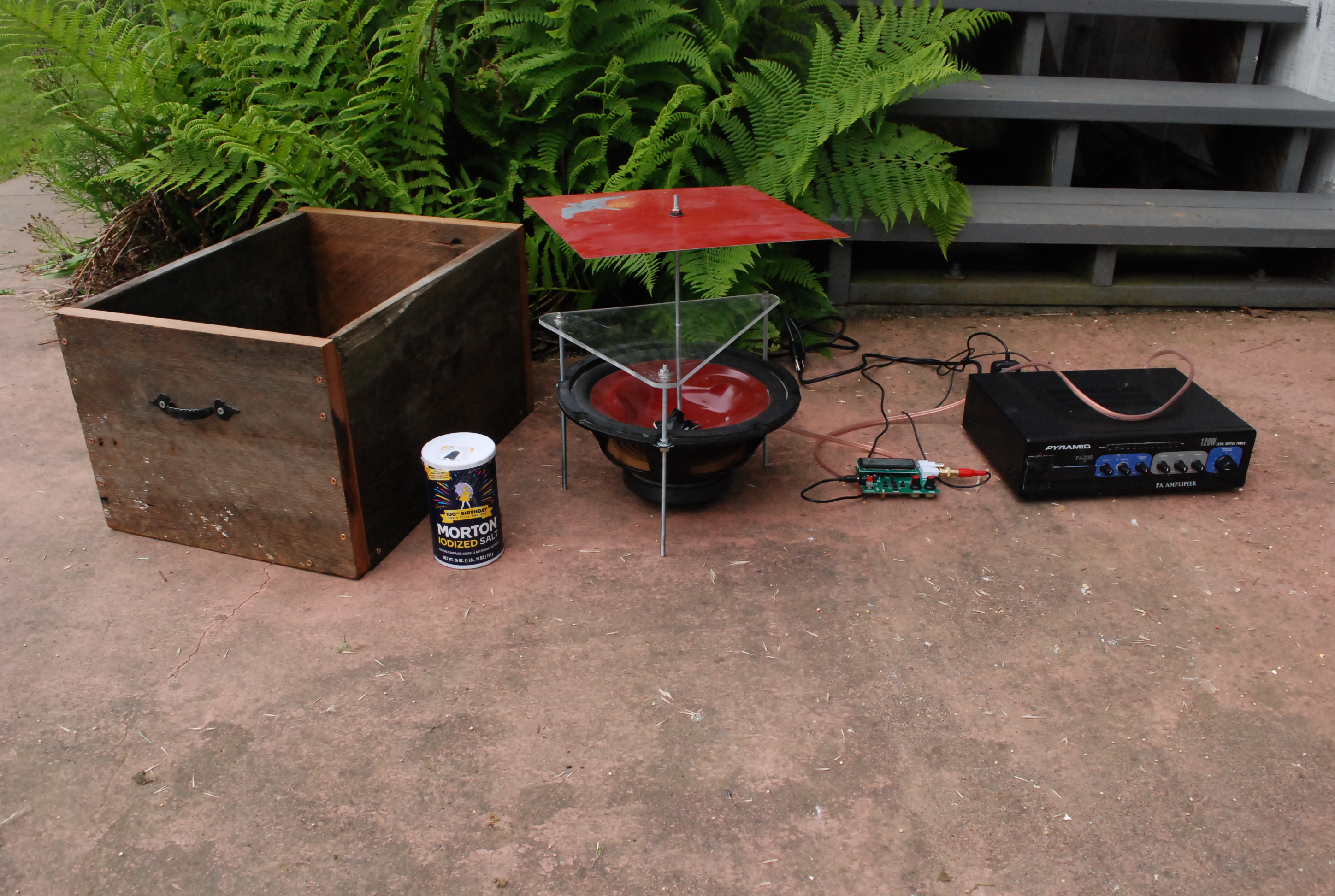
Costs
The total cost for the resonance demonstration was fairly inexpensive mainly due to the generous donations. The most expensive components of the design are the subwoofer, amplifier and redwood box. The redwood box is not a necessity for a working demonstration; however, it is very useful in housing and transporting all of the individual components.
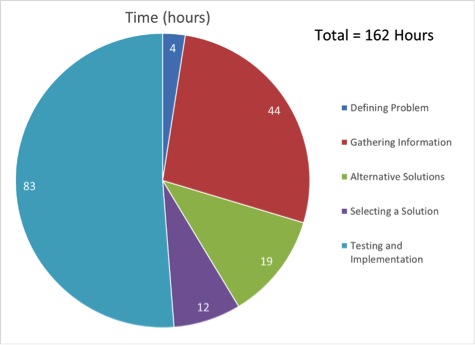
| Quantity | Material | Cost ($) | Total ($) |
|---|---|---|---|
| 20 | Hardware | .30 | 6.00 |
| 10 | Hooks | .20 | 2.00 |
| 2 | Spray Paint | 2.50 | 5.00 |
| 1 | Super Glue | 4.49 | 4.49 |
| 1 | Shelf Bracket | 7.99 | 7.99 |
| 2 | Dowel (1" x 48") | 5.99 | 11.98 |
| 4 | Threaded Rod (1/4"x 24") | 2.99 | 11.96 |
| 2 | Adapters | 7.99 | 15.98 |
| 1 | Pyramind PA Amplifier | 32.99 | 32.99 |
| 1 | Function Generator | 22.99 | 22.99 |
| 1 | Chladni Plate | Donated! | Donated! |
| 1 | Redwood (3/4" x 14" x 6') | Donated! | Donated! |
| 1 | Subwoofer | Donated! | Donated! |
| Sub Total | $121.38 | ||
| Tax (8.25%) | $10.01 | ||
| Total Cost | $131.39 | ||
Testing Results
Through several days of testing, the team has been able to find a range of frequencies at which the Chladni Visual Demonstration functions best. The optimal operation is at frequencies between 75-350Hz. The frequencies generated by the Chladni Visual Demonstration Unit, while not the exact replicas of, are comparable to the patterns shown on other mechanical wave drivers at similar frequencies. Salt poured on the plate forms several different unique geometric patterns. The redwood box has cut down on some of the excessive volume of the speaker. Team Resonauts have shown the design to Mr. Pinkerton who is enthusiastic about employing the demonstration for future demonstrations in his classroom at Zane Middle School. The demonstration unit has been debuted with success at the Humboldt Math Festival at the Bayshore Mall in Eureka as seen in the pictures below. People of all ages were interested to see the demonstration and play with the salt as different shapes would form on the plate. Kids really enjoyed being able to pour salt on the plate themselves and see the different patterns that formed. Kids were fascinated with the different shapes that formed and many of them kept playing with the salt and were amazed at how the disrupted patterns always vibrated back to form.
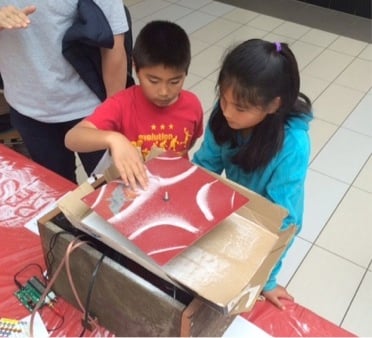
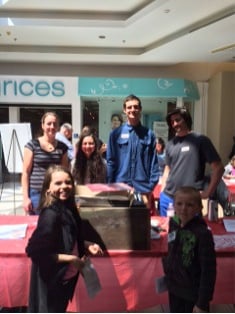
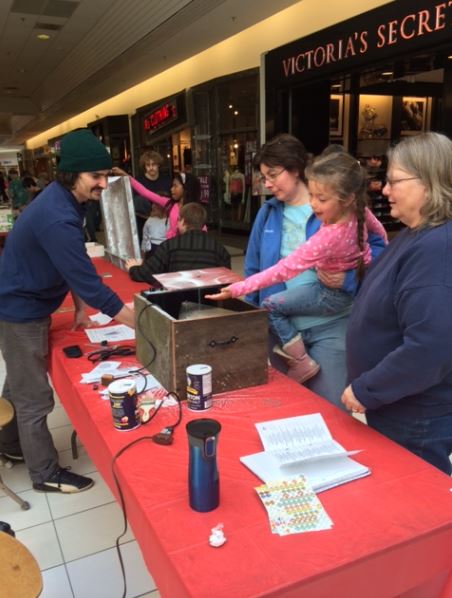
How to build
Special Thanks!
The Resonauts want to give a special thanks to everyone who made this project a possibility. The resonauts had a great time working on this project and appreciate having this amazing opportunity. We have learned so much throughout the whole process. Thank you Andy Alm, Marty Reed, Ken Pinkerton, Lonny Grafman, Audio Specialties, Zane Middle School and Humboldt Bay Trade and Pawn.
References
See Help:Footnotes for more. Template:Reflist Billah, Yusuf K. (1991). “Resonance Tacoma Narrows Bridge Failure and Undergraduate Physics Textbooks”, American Journal of Physics Vol. 59 Biological Magnetic Resonance, Volume 19: Distance Measurements in Biological Systems by EPR (Berliner, Lawrence J., Eaton, Sandra S., Eaton, Gareth R. 2007).
Carnegie Mellon University (CMU). (2013). “Lead Soldering Safety Guidelines.” <http://www.cmu.edu/ehs/chemical/Lead%20Soldering%20Safety%20Guidelines.pdf> (Feb. 20, 2015).
Cook, Perry R. (2002), “Real Sound Synthesis for Interactive Applications”, AK Peters Natchick, Mass.
Dukes, Phillip. (2005). “An inexpensive resonance demonstration.” Journal of College Science Teaching, 34(4), 68-70. <http://www.nsta.org/publications/news/story.aspx?id=50119> (Feb. 20, 2015).
Environmental Protection Agency (EPA). “Common Recyclable Materials.” Recycling, <http://www.epa.gov/smm/wastewise/pubs/commonmats.pdf> (Feb. 21, 2015).
Eureka City Schools 2014-2015 Parent and Student Handbook (Feb. 19, 2015).
Forde. (2010). “Bonding Strength of Wood Materials.” Construction and Building Materials, 24(12), 2628-2632. <http://www.sciencedirect.com/science/article/pii/S0950061810002138> (Feb. 19, 2015).
“Goals of the Humboldt Math Festival.” <http://humboldtmathfestival.weebly.com/goals.html> (Feb. 19, 2015).
Goodheart Wilcox Co. “Division 05 – Metals.” Construction Materials – Types and Uses, <http://www.g-w.com/pdf/sampchap/9781590703472_ch10.pdf> (Feb. 20, 2015). Pdf.
Gustafson, Grant B. (2009). “Resonance.” In Engineering Math (5.8). Retrieved from: <http://www.math.utah.edu/~gustafso/2250resonance.pdf> (Feb. 20, 2015). Pdf.
Harvard College. (2013). “Tuning Forks.” Simple Harmonic Motion, <http://www.fas.harvard.edu/~scdiroff/lds/OscillationsWaves/TuningForks/TuningForks.html> (Feb. 20, 2015). Pdf.
Knight, Randall D. (2013) Physics for Scientists and Engineers a Strategic Approach, 3 Ed., Pearson
Lapp, D. (2006). The Physics of Music and Musical Instruments Wright Center for Science Education Tufts University, Medford, Massachussets, 8-38.
Laws, P., Sokoloff, D., and Thornton, R. (1999). "Promoting active learning using the results of physics education research." UniServe Science News, 13, 14-19.
Mazzolini, A. P., Daniel, S., and Edwards, T. (2012). “Using interactive lecture demonstrations to improve conceptual understanding of resonance in an electronics course.” Australasian Journal of Engineering Education, 18(1), 69.M <http://web.mit.edu/8.01t/www/materials/modules/chapter23.pdf> (Feb. 20, 2015). Pdf.
National Institute of Biomedical Imaging and Engineering. “Magnetic Resonance Imaging (MRI).” <http://www.nibib.nih.gov/science-education/science-topics/magnetic-resonance-imaging-mri> (Feb. 20, 2015).
Perseh, Bahram; Kiamini, Majid. (2013). “Optimizing Feature Vectors and Removal Unnecessary Channels in BCI Speller Application.” Journal of Biomedical Science and Engineering, 6, 973-981.
Physics Classroom. “Standing Wave Patterns.” Sound Waves and Music, <http://www.physicsclassroom.com/class/sound/Lesson-4/Standing-Wave-Patterns>. (Feb. 21, 2015).
Rutgers. (2010). “What Are Sustainable Materials?” Center for Sustainable Materials, <http://sustain.rutgers.edu/what_are_sustainable_materials>. (Feb. 21, 2015).
Science & Health Education Partnership (SEP). “Oobleck.” SEP Lessons, <http://seplessons.ucsf.edu/node/3465> (Feb. 18, 2015).
Senese, Fred. (2010). “What is a non-Newtonian Fluid?” General Chemistry Online, <http://antoine.frostburg.edu/chem/senese/101/liquids/faq/non-newtonian.shtml> (Feb. 21, 2015).
Stony Brook University. (2009). “Soldering Safety.” Environmental Health and Safety, <http://naples.cc.sunysb.edu/Admin/HRSForms.nsf/pub/EHSD0348/$File/EHSD0348.pdf> (Feb. 20, 2015). Pdf.
Torlakson, Tom. “Common Core State Standards.” <http://www.cde.ca.gov/> (Feb. 20, 2015).
University of Maryland (UMD). (). “Speaker and Candle.” Physics, <http://www.physics.umd.edu/deptinfo/facilities/lecdem/services/demos/demosh1/h1-02.htm> (Feb. 20, 2015).
University of Salford, Manchester. (). “Damping.” Simple Harmonic Motion, <http://www.acoustics.salford.ac.uk/feschools/waves/shm2.php#damping> (Feb. 20, 2015).
Vermont Safety Information Resources Inc (SIRI). (1985). “Materials Safety Data Sheet – Cornstarch.” Hazard, <http://hazard.com/msds/index.php> (Feb. 18, 2015).
